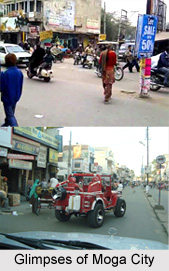 Moga is a city in the Punjab state of India. The name Moga was given after Moga Singh Gill, a prominent person of the Gill community in Punjab. The city is said to be the best personification of the rich Malwa culture. Moga is renowned for its Gangsters and aggressive spirited Students all over Punjab. Even today, Moga is considered as the heartland of Punjab Gangsters.
Moga is a city in the Punjab state of India. The name Moga was given after Moga Singh Gill, a prominent person of the Gill community in Punjab. The city is said to be the best personification of the rich Malwa culture. Moga is renowned for its Gangsters and aggressive spirited Students all over Punjab. Even today, Moga is considered as the heartland of Punjab Gangsters.
Location of Moga
Moga is situated on the National Highway 95. With an average elevation of 217 metres, the city is bordered by Jalandhar district in the north, Ludhiana district in the East, Sangrur in the South and Faridkot and Ferozpur in the West. It is spread over an area of 2230 km2 in Punjab. It is situated around 368 km from New Delhi, 184 km from Chandigarh, 67 km from Ludhiana, 110 km from Amritsar, 85 km from Bathinda and 1600 km from Mumbai. The official language of Moga is Punjabi.
History of Moga
Moga can trace its history back to a couple of millennia ago. The city developed because of Railway development. It was the last stop of Rail line. The city Moga became a part and headquarters of 17th District in the state of Punjab on 24th day of November 1995, by then Chief Minister Harcharan Singh Brar. Earlier, Moga was a part of Faridkot District as a tehsil. The area of Dharamkot block, comprising 150 villages, has been merged into Moga district, which falls under the jurisdiction of Ferozpur division.
Demographics of Moga
According to the 2011 census, Moga had a population of 159,897 of which males were 84,808 and females were 75,089. The literacy rate was 81.42 per cent.
Moga is home to the highest percentage of Sikh population among all the districts of Punjab. As per 2001 census, Sikhs form around 87.5 per cent of the total population in Moga. The other religions found here include Hindus, Dev Smajis, Nanakpanthis, Dera Sacha Saudis and Ravidasis.
Highlights of Moga
Moga is known for being the birth place of Lala Lajpat Rai, the great freedom fighter. Moga became a popular spot for travelling to Lahore. People came by train to Moga and after that, people travelled to Lahore (now in Pakistan) via Buses. It also became a trading centre for Tea which was transported on Train, for which it was called "Moga Chah Joga" meaning Moga only has Tea. Apart from this, the city is known for launching India`s first Nestle production plant. The plant was launched in Moga in the year 1961 and was termed "Jewel of the crown" of company`s investment across the globe.



















